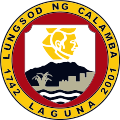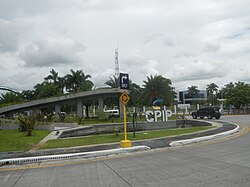Calamba City
Calamba City is a component city in the province of Laguna, Philippines. It is the regional city center of Calabarzon region, after Lucena City, The City is one of the fastest growth city in region 4A and one of the planning urban cities in Urban Laguna and by growth population, which is divided into barangays, because of its economic some, commercials, entertainment, companies are served in city, Calamba City is 54 kilometres (34 mi) south of Manila. Calamba City is a popular tourist destination. It has several hot spring resorts. Most of these are in Barangay Pansol. There are 651 resorts and hot springs in the city. The Canlubang Golf and Country Club has been the host of many Philippine Opens. Calamba is also an important modern industrial center in the CALABARZON region. This is shown by the large number of industrial parks and business estates in the city. 454,486 people live in the city (2015). There are in 58,466 households. Calamba City is the most populated city in Laguna province. San Pedro, Santa Rosa City, Biñan City, and San Pablo City follow it as the top 5 municipalities and cities by number of people in the province.
| {{safesubst:#property:P1448}} | |
|
| |
|
| |
| Anthem: "Calamba Hymn" | |
| {{safesubst:#property:P242}} Map of {{safesubst:#property:P131}} with Calamba City highlighted | |
OpenStreetMap Lua error in Module:Infobox_mapframe at line 118: attempt to index field 'wikibase' (a nil value). | |
| Coordinates: Lua error in Module:Coordinates at line 614: attempt to index field 'wikibase' (a nil value). | |
| Country | Philippines |
| Region | {{safesubst:#property:P131}} |
| District | [] |
| Founded | August 28, 1742 |
| Cityhood | April 21, 2001 |
| Barangays | (see Barangays) |
| Government | |
| • Mayor | Roseller "Ross" H.Rizal |
| • Vice Mayor | Angelito S. Lazaro Jr. |
| • Representative | Charisse Anne C. Hernandez |
| • City Council | List
|
| • Electorate | 332,844 (2022) |
| Highest elevation | 1,095 m (3,593 ft) |
| Lowest elevation | 2 m (7 ft) |
| • Rank | 20th |
| Economy | |
| • Income class | {{safesubst:#property:P1879}} |
| • Poverty incidence | % (?)[3] |
| • Revenue | ₱ |
| • Assets | ₱ |
| • Expenditure | ₱ |
| • Liabilities | ₱ |
| Service provider | |
| • Electricity | — |
| • Water | Calamba Water District |
| Time zone | UTC+8 (PST) |
| ZIP code | {{safesubst:#property:P281}} |
| PSGC | |
| Native languages | {{safesubst:#property:P2936}} |
| Patron saint | Saint John the Baptist |
| Website | http://{{safesubst:#property:P856}} |
Calamba City is the birthplace of José Rizal. He is a national hero in the Philippines.
History
The name of the city comes from a legend. The legend says that during the early time of the Spanish period in the country, two "guardias civil" or Spanish soldiers were lost. As they moved through the area that is now Calamba, they met a young woman. She came from a river carrying a jar of water and a wooden stove. The soldiers asked the lady what the name of the place was. They asked this in Spanish and used an angry tone to hide the fact that they were lost. She did not speak Spanish and thought she was being questioned about what she was carrying. She answered "kalan-banga", meaning "clay stove" (kalan) and "water jar" (banga). Because they could not pronounce it correctly, the city has been called Calamba since then. This legend is immortalized with a large concrete water jar built in the city plaza with the names of the city's barangays written on it. It is said to be the World's Biggest "Claypot". This same jar is also in the city's seal. The idea to build the plaza came from Dr. Agapito Alzona. He was a town councilor at the time. It was built on an unused area that was at one time the old town market. The plaza was built in 1939.
Before it became a separate city, Calamba was a part of Tabuco. Tabuco is now known as Cabuyao, Laguna. Calamba became an independent pueblo on August 28, 1742.
While the area was under the control of the Japanese in World War II, the city was the site of a massacre. The Imperial Japanese Army killed at least 2,000 civilians.[6]
With the passage of Republic Acts of the Philippines-Republic Act,No. 9024 on April 7, 2001 and the approval of the people on April 21, Calamba went from being a municipality into being Laguna's second component city. San Pablo City was the other component city at the time. Calamba is seen as a major growth center.
On October 28, 2003, Calamba City became the regional center of Region IV-A CALABARZON.
Calamba has been the home to five national heroes: Dr. Jose Rizal, General Paciano Rizal, Teodora Alonzo, General Vicente Lim, and Lt. Geronimo Aclan.
The main church in Calamba City is the St. John the Baptist Church. It was built in 1859. The church was burned by the Japanese during World War II. It was rebuilt by Fr. Eliseo Dimaculangan. It was the christening site of Jose Rizal. The original baptismal front has been is still there.
Calamba City Media
Photos of Downtown, Crossing (Junction) and the New Calamba City Hall Complex - [1] Chipeco Avenue, Real, a 4-storey building excluding the penthouse. It has approximately 9,000 sq.m. of floor area. Coordinates: 14°11'38"N 121°9'35"E --- Calamba, Laguna[2] (NSCB: 043405000) is a component city of Laguna, [3]
References
- ↑ Pa-a, Saul (April 6, 2019). "Calamba resorts without accreditation face closure". Philippine News Agency. https://www.pna.gov.ph/articles/1066638. Retrieved January 30, 2020.
- ↑
- ↑ Script error: The function "reference" does not exist.
- ↑ Script error: The function "reference" does not exist.
- ↑ "2015 Census of Population, Report No. 3 – Population, Land Area, and Population Density" (PDF). Philippine Statistics Authority. Quezon City, Philippines. August 2016. ISSN 0117-1453. Archived (PDF) from the original on May 25, 2021. Retrieved July 16, 2021.
- ↑ Jintaro Ishida, The Remains of War, 2001, p.238, citing the Barangay Real Memorial.
Other websites
- Calamba City Website Archived 2016-08-05 at the Wayback Machine
- Calamba, Laguna Website[dead link]















